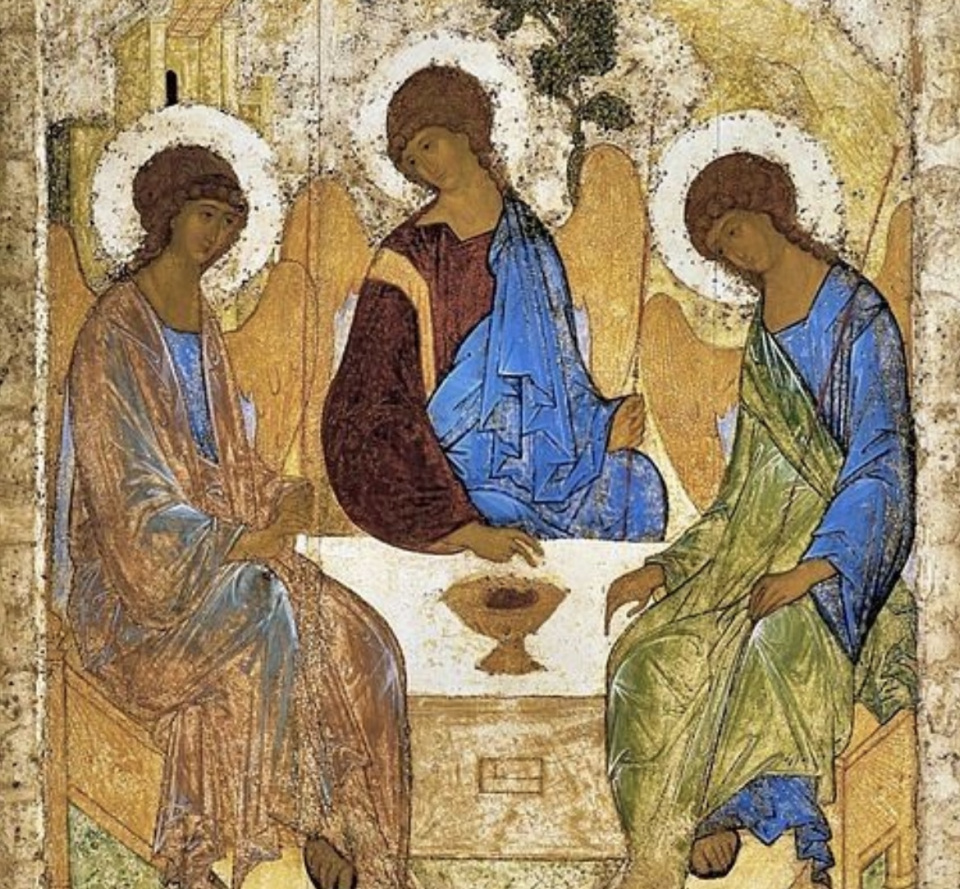The Sunday Project

A Seat at the Table
The Most Holy Trinity |
By Michael Therese McQueen

So Moses cut two tables of stone like the first; and he rose early in the morning and went up on Mount Sinai, as the LORD had commanded him, and took in his hand two tables of stone. And the LORD descended in the cloud and stood with him there, and proclaimed the name of the LORD. The LORD passed before him, and proclaimed, "The LORD, the LORD, a God merciful and gracious, slow to anger, and abounding in steadfast love and faithfulness, And Moses made haste to bow his head toward the earth, and worshiped. And he said, "If now I have found favor in thy sight, O Lord, let the Lord, I pray thee, go in the midst of us, although it is a stiff-necked people; and pardon our iniquity and our sin, and take us for thy inheritance."
Finally, brethren, farewell. Mend your ways, heed my appeal, agree with one another, live in peace, and the God of love and peace will be with you. Greet one another with a holy kiss. All the saints greet you.
For God so loved the world that he gave his only Son, that whoever believes in him should not perish but have eternal life. For God sent the Son into the world, not to condemn the world, but that the world might be saved through him. He who believes in him is not condemned; he who does not believe is condemned already, because he has not believed in the name of the only Son of God.
Many people are familiar with Rublev's famous icon of the Trinity, depicting the Holy Trinity as the three angels that appeared to Abraham in Genesis 18: 1-8. We see God the Father arrayed in Gold sitting to the Left of the Table overseeing the world (symbolized by the dish in the center of the table), we see God the sun arrayed in humanity (red) and divinity (blue) his hand resting at the table, symbolizing his incarnation and direct interaction with the human world, and finally we see God the Holy Ghost dressed in verdant green, hands gently hovering above the table representing that he is the life force that renews and reanimates the world. There’s a curious feature in the Rublev icon if you look at the base of the icon there is a small square that seems almost out of place, this small square has been a mystery to many for years.
Many art historians agree that at one time a mirror occupied the place where the square now sits empty. It is believed that when people would contemplate and pray with the icon, they would have no choice but to see their own reflection staring back at them, including them at the table with the Eternal Godhead. What is important about this? Why is there such a feature in an icon of the central mystery of Christianity? The answer can be found in the Eastern Churches concept of Theosis (Literally meaning to make divine) by this concept through the sanctifying gift of the Holy spirit, we are brought into a union with God where God shares divinity with us, a mystical marriage in which The Divine in infinite love and generosity shares it’s life with humanity growing in holiness. As we grow in closer union with God we are brought closer to God’s Divinity and God shares that Divinity with us.
What we are shown by this is that the central mystery of Christianity is not one that is meant to be pondered over and mystified over but one that seeks to include us into its very fabric, giving us a seat at the table, the mystery of salvation is no longer a spectator sport. It is something we become intimately involved in. In the Gospel readings for this Sunday we see the ways in which God has interacted with humanity throughout Salvation History, the giving of the law through Moses on Mount Sinai, In the Fellowship of the Holy Spirit, and The Incarnation of Jesus we see the Trinity acting throughout the whole of human history seeking to bring us closer, always seeking a relationship, a Divine Romance, it is through the incarnation of Jesus that we become invited to the table of Divinity.
Through the Incarnation of Christ we become active participants in God’s saving and redeeming work, we are just called to grow closer, we are called to fall in love, we are called to claim our seat that has been prepared for us at the Table.